Vintage Treasures: Isaac Asimov’s Wonderful Worlds of Science Fiction 1: Intergalactic Empires edited by Isaac Asimov, Martin H. Greenberg, and Charles G. Waugh
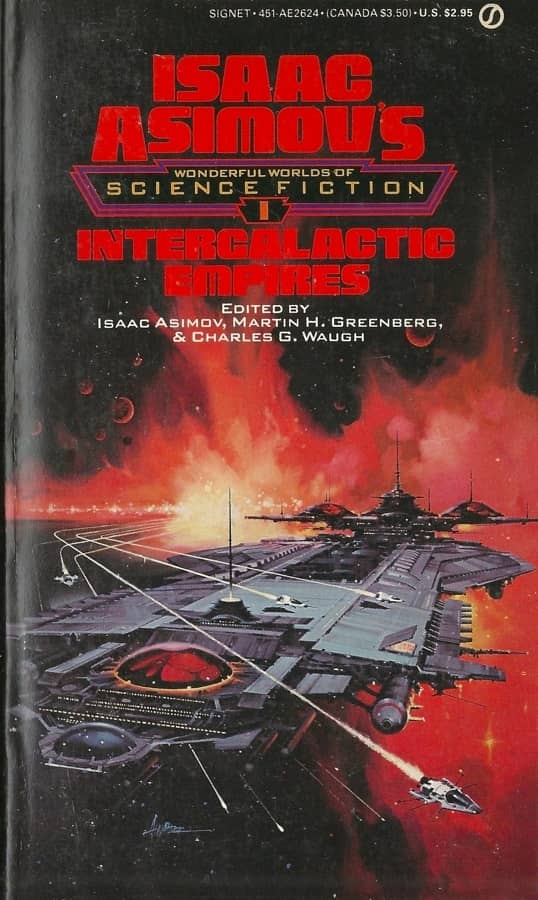 |
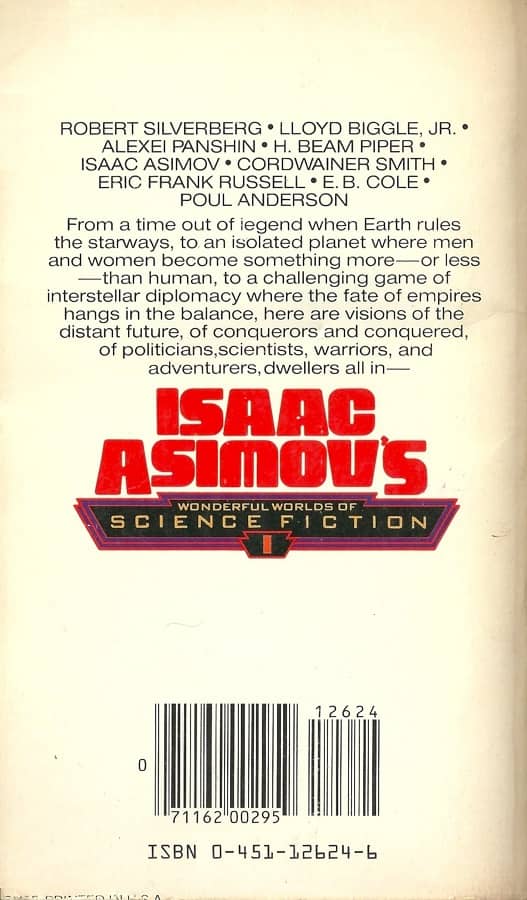 |
Isaac Asimov’s Wonderful Worlds of Science Fiction 1: Intergalactic Empires
(Signet, December 1983). Cover by Paul Alexander
Last year, while I was researching an article on Asimov’s industry-changing success as a science fiction anthologist, I came across some amazing stats. Here’s the summary:
The Internet Science Fiction database lists nearly 200 anthologies with Asimov’s name on them, averaging around seven per year between 1963 and his death in 1992… the vast majority were produced in partnership with a team of editors, especially Martin H. Greenberg and Charles G. Waugh. In the early days Asimov compiled anthologies the old-fashioned way: by himself. It was the enduring, decades-long success of those books that paved the way for the massive literary-industrial complex to spring up around Asimov in the 80s and 90s.
Ha! That ‘literary-industrial complex’ line still busts me up. But the really interesting thing to come out of all that research was an obsession to track down all ten volumes in Isaac Asimov’s Wonderful Worlds of Science Fiction, starting with Volume 1, Intergalactic Empires. In the process I also managed to find the last surviving editor of the series, Charles G. Waugh, who proved a fascinating correspondent.
Inside cover page of Isaac Asimov’s Wonderful Worlds of Science Fiction 1: Intergalactic Empires
Here’s an excerpt from one of the emails I received from Charles.
Over my 47 year career at UMA I averaged 5 books a year teaching 5 classes in 2 disciplines… Isaac’s death affected our ability to sell reprints, and while Marty and I both were idea machines, I think I was the one who proposed doing original theme anthologies… What I have always done since 4 was read. I can’t remember people’s names, but I do remember stories, so when I do come up with an idea for a theme anthology, I can usually think of a number of stories that would work and remember where to find them. However, I also do a lot of research. Now the net allows me to find more stuff much more efficiently… I look for well-written stories, that have interesting ideas, and move along. For books, I try for a variety of themes, minimal overlap with competing anthologies, and a liberal inclusion of obscure stories…
Before I shuffle off this mortal coil am I am trying to produce as many quality theme anthologies as I can as a legacy… and as a way to honor those brave and crazy people (neither of which I am) who decided to become authors, who spent their lives building myths and spinning tales for us, usually not earning much money, and ended up much too frequently (I would estimate 5 to 10% from the 100s of author bios I have done) committing suicide, or dying in poverty. It’s my way of saying to them your life did have meaning, and some of us, at least, deeply appreciate what you did.
Charles expresses a powerful sentiment in that last paragraph. In two short sentences he manages to put into words precisely what has driven many of us at Black Gate to do what we do, day after day, for over two decades.
Charles has continued to edit and publish anthologies, most with SamTeddy Publishing, including Before Weird Tales: Early 20th Century Stories Of Horror and the Supernatural, African Horrors, Frontier Women: 26 Classics Tales, Weird Trails, and dozens more.
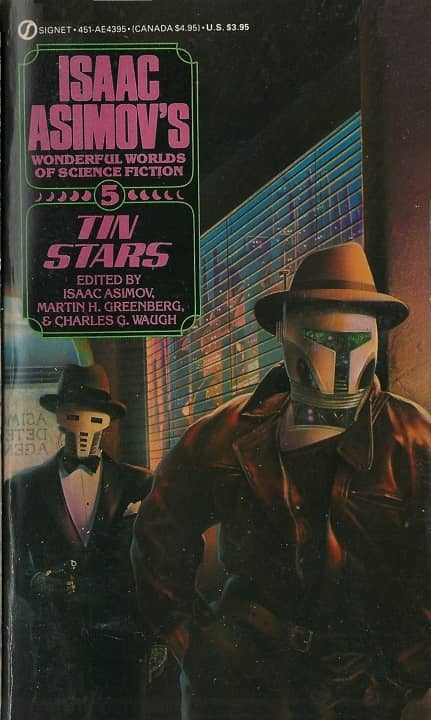 |
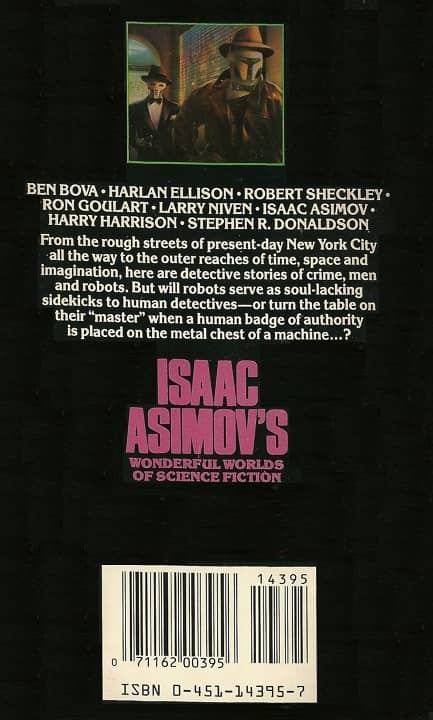 |
Tin Stars (Signet, 1986), volume 5 of Isaac Asimov’s Wonderful Worlds of Science Fiction. Cover by JAV
I wrote about Volume 5 in the series, Tin Stars, in A Fine Addition to any SF Library: Isaac Asimov’s Wonderful Worlds of Science Fiction last year. And in the Comments section, SilentDante articulated my feelings better than anything I said:
Holy crap, that cover of the Tin Stars volume is exactly what i love, it evokes crime/hard boiled noir detectives with futuristic themes… i need to find this copy, even if none of the stories match the cover, i want it! the sheer potential it says to me… hahaha thanks for the great article.
I think it was that swell of enthusiasm (not to mention shared nostalgia) in the comments section that helped fire my interest in tracking down all 10 volumes. Intergalactic Empires is a terrific one to start with. It showcases the authors and series that made star-spanning empires such a rich and enduring theme in science fiction, with a novella by Robert Silverberg, a Foundation story by Isaac Asimov, a Dominic Flandry tale by Poul Anderson, an Instrumentality of Mankind novelette by Cordwainer Smith, a Terran Federation story by Lloyd Biggle, Jr, an Empire Era tale by H. Beam Piper, and much more.
In his introduction, Asimov largely takes credit for inspiring SF writers’ fascination with galactic empires — including George Lucas. Here’s Asimov.
The empire remains the favorite symbol of the large state, and it has taken over the imagination of the science fiction world. Nor is it the most recent empires, after the fashion of the British, that are used as models. Rather, the mood, the atmosphere. the paraphernalia is that of ancient and medieval times.
For this, I myself am largely responsible. There were, before my time, stories about Earthmen meeting other intelligences, or living on other worlds as well as Earth, of conquering or being conquered, but the first attempt to write a series of such stories with a rational historical background, and to achieve considerable popularity as a result, was mine. It was my Foundation series, which began appearing in 1942, that set the fashion.
In 1942, to be sure, the European empires, particularly the British, were still in existence, and seemed likely to be eternal, but they didn’t influence me. I modeled my “Galactic Empire” (a phrase I think I was the first to use) quite consciously on the Roman Empire.
Ever since then, other science fiction writers have been following the fashion, and have written series of their own after the fashion of the Foundation series. In fact, in the late 1970s the Galactic Empire reached the movies in the enormously popular Star Wars, which, here and there, offered rather more than a whiff of the Foundation. (No, I don’t mind. Imitation is the sincerest form of flattery, and I certainly imitated Edward Gibbon, so I can scarcely object if someone imitates me.)
In this book, then, we have nine stories by nine authors illustrating nine different versions of Galactic Imperial history, since each is part of a series of at least three stores. One story included is, inevitably, one of mine, and it happens to be one that is the least typical of my empire stories.
Here’s the complete Table of Contents, including Asimov’s introduction and three 2-page essays by the editors that break the book into sub-themes: Cycles, Governance, and Concerns.
Introduction: Empires, by Isaac Asimov
Cycles, by the editors
“Chalice of Death” by Robert Silverberg (1957)
“Orphan of the Void” by Lloyd Biggle, Jr. (1972)
“Down to the Worlds of Men” by Alexei Panshin (1963)
Governance, by the editors
“Ministry of Disturbance” by H. Beam Piper (1958)
“Blind Alley” by Isaac Asimov (1945)
“A Planet Named Shayol” by Cordwainer Smith (1961)
Concerns, by the editors
“Diabologic” by Eric Frank Russell (1955)
“Fighting Philosopher” by Everett B. Cole (1954)
“Honorable Enemies” by Poul Anderson (1951)
Intergalactic Empires doesn’t contain an entry from every skilled practitioner of empire-themed space opera in the 20th Century, but it does everything I wanted it to: include many of my favorites, and simultaneously introduce me to a diverse range of far-flung settings I’ve never visited before.
All ten volumes in the series
Altogether there are ten volumes in Isaac Asimov’s Wonderful Worlds of Science Fiction, and if I live long enough I expect I’ll have something to say about each of them. Here’s the complete list.
1 Intergalactic Empires (1983)
2 The Science Fictional Olympics (1984)
3 Supermen (1984)
4 Comets (1986)
5 Tin Stars (1986)
6 Neanderthals (1987)
7 Space Shuttles (1987)
8 Monsters (1988)
9 Robots (1989)
10 Invasions (1990)
All were published as paperback originals by Signet. They have never been reprinted.
Intergalactic Empire was published by Signet in December 1983. It is 304 pages, priced at $2.95 in paperback. The cover is by Paul Alexander. The book has never been reprinted, and there is no digital edition.
See all our coverage of the best vintage SF and fantasy books here.
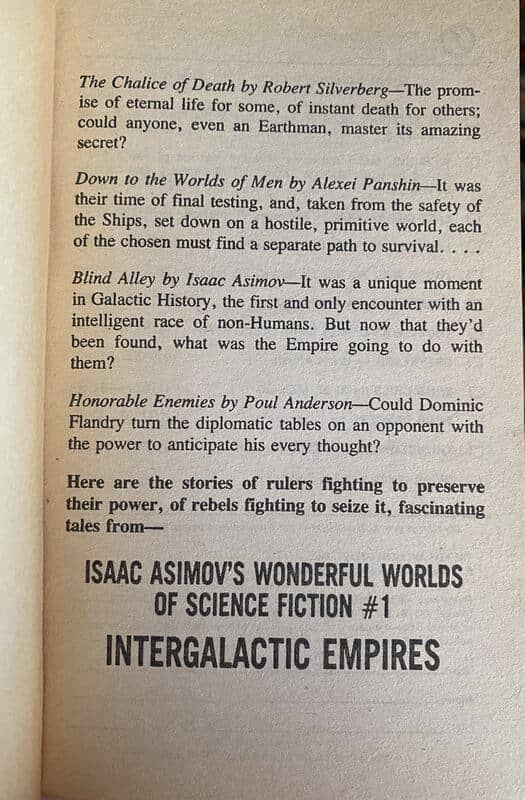
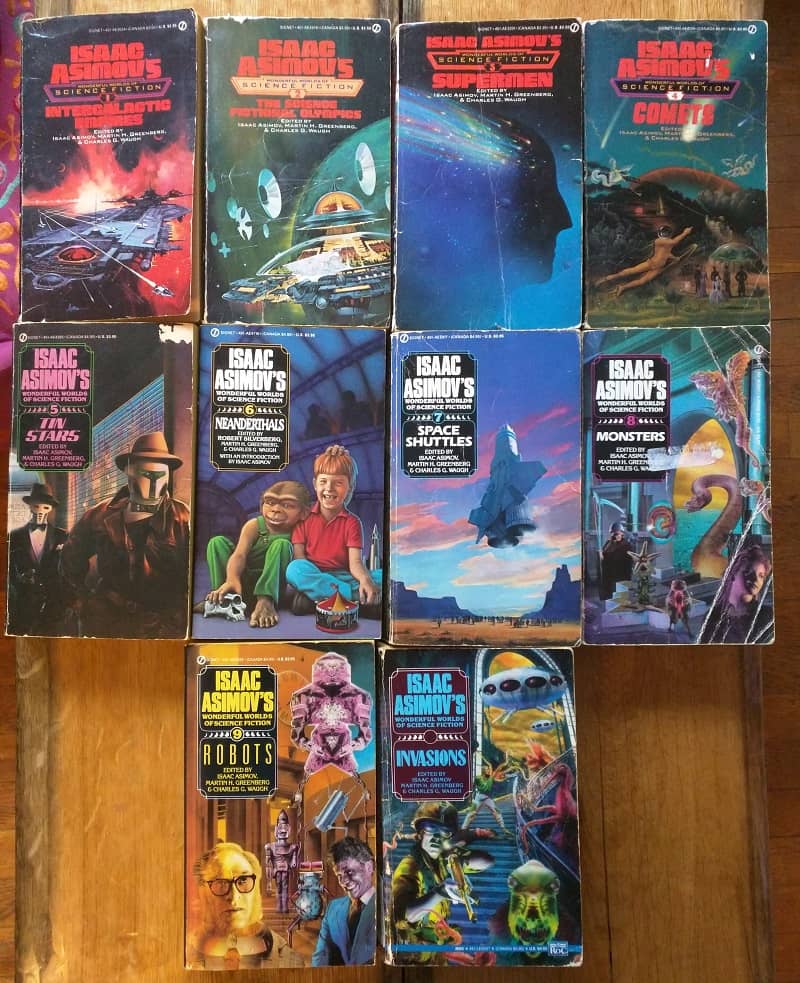
A wonderfully humane statement by Mr. Waugh on his editing endeavors, bringing recognition to the “ink-stained wretches” who so marvelously filled the pages of pulps and paperbacks and the minds of fans who coveted their work (if not always understanding how poorly it paid). Many more years of collecting and publishing I wish for Mr. Waugh.
And the same to his Boswell, the estimable fan/publisher Mr. John O’Neill. Looking forward to more installments on the “Asimov’s Wonderful Worlds” volumes.
Thanks Eugene. I’d love to write about more in the series. We’ll see if I get to cover them all. 🙂
Great post, John, a delight to read. Also, that Paul Alexander cover on the “Intergalactic Empires” volume is just fantastic – really set my “SF cover nostalgia” neurons firing.
I agree completely. Nobody does epic spaceships like Paul Alexander! He did one more cover for the series, for the second volume, THE SCIENCE FICTIONAL OLYMPICS.
J.K. Potter took over cover duties for the last three. I love Potter’s horror stuff, but I thought he was a surprising choice. Still, I thought he did fine work here.
Once again you have set me longing for a batch of old SF paperbacks. **SIGH** I’ll just take a spin over to the market, I’m sure these are all, brand new, sitting in the spinner rack between the magazines and the liquor department. But no. Instead I’ll be glad and impressed by you having the set. Well done.
RK — I don’t have the complete set yet! Still missing four of the later volumes. But they shall soon be mine. 🙂
Not the same series but perhaps worth a mention is Where Do We Go From Here, edited by Isaac Asimov. I mention it as I picked up vol 1 today. Depending on publisher it was either a one off ot a two volume set.